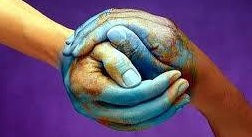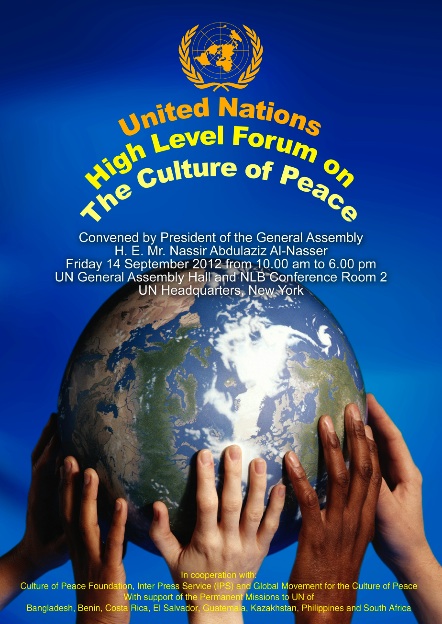“It may seem sometimes as if a culture of peace does not stand a chance against the culture of war, the culture of violence and the cultures of impunity and intolerance. Peace may indeed be a complex, dependent on action in many fields and even a bit of luck from time to time. It may be a painfully slow process, and fragile and imperfect when it is achieved. But peace is in our hands. We can do it.”– Former UN Secretary-General Kofi Annan

Observances and activities for the U.N. International Day of Peace (Peace Day) take place on and around September 21, yet Peace Day has an impact on people and communities both before and after this global day, and forwards a “Culture of Peace.”
The United Nations Educational, Scientific and Cultural Organization and the United Nations Alliance of Civilizations play an important role in fostering the intercultural dialogue. They conduct activities related to the culture of peace and non-violence and make efforts in promoting a culture of peace through a number of practical projects in the areas of youth, education, media and migration, in collaboration with governments, international organizations, foundations and civil society groups, as well as the media and the private sector.
As defined by the United Nations, “Culture of Peace” is a “set of values, attitudes, modes of behavior and ways of life that reject violence and prevent conflicts by tackling their root causes to solve problems through dialogue and negotiation among individuals groups and nations.” Since its founding over 60 years ago, UNESCO (United Nations Educational Scientific and Cultural Organization) asserted that, “since wars begin in the minds of men, it is in the minds of men that the defenses of peace must be constructed.”
For the “8 Action Areas for a Culture of Peace” Hand-Out, CLICK HERE
For a description of the concept and history of the Culture of Peace, CLICK HERE
Kosmos Journal Interview: Ambassador Anwarul K. Chowdhury on the Culture of Peace – December 2015
Kosmos Journal by Dot Maver, Ph.D.: The Invisible Yet Existent Culture of Peace, CLICK HERE
In 1997, the UN General Assembly proclaimed the year 2000 as the International Year of the Culture of Peace. In 1999, Ambassador Anwarul K. Chowdhury (former Under-Secretary General and High Representative of the UN and President of UNICEF, among other high-level roles), spearheaded an initiative that led to the adoption of a landmark Programme of Action on a Culture of Peace and proclamation of the International Decade for a Culture of Peace and Non-Violence for the Children of the World (2001-2010). UNESCO was designated as the lead UN agency for this decade.
A document called “Manifesto 2000” for a culture of peace and non-violence was drafted by a group of Nobel Peace Prize laureates, to translate the resolutions of the United Nations into everyday language and to make them relevant to people everywhere. CLICK HERE for the Manifesto 2000.
The key pledges of the Manifesto 2000 are to: Respect the life and dignity of each human being; Practice active non-violence; Share my time and material resources; Defend freedom of expression and cultural diversity; Promote consumer behavior that is responsible and Contribute to the development of my community.
The concept of a Culture of Peace has now grown into a global movement. Within the Culture of Peace framework, peace embraces far more than an absence of conflict. It encompasses tolerance, disarmament, sustainable economic and social development, democratic participation, gender equality, freedom of expression and respect for human rights. The transition from a culture of war to a Culture of Peace requires the transformation of individual behavior as well as institutional practices. Learning to live in peace and harmony is a long-term process, and begins with the development of inner peace, and nurturing attitudes that promote the expansion and integration of peaceful principles. Education and awareness-raising play a key roles in this process.

In September 2012, the United Nations presented the first ever High Level Forum on the Culture of Peace, which was open to civil society. This Forum has occurred annually since then. As part of his remarks during the Forum, former UN General-Secretary Ban-Ki Moon stated:“We are here to talk about how to create this culture of peace. I have a simple, one-word answer: education.” He stressed that, through education, children could be taught not to hate and leaders could be taught to act with wisdom and compassion.
In 2022, the United Nations again hosted a Culture of Peace Program. Please click HERE for the program booklet.
For more background information and documents about the Culture of Peace from the UNESCO website, CLICK HERE.
For Ambassador Chowdhury’s 2007 Talk,”Building A Culture of Peace,” CLICK HERE.
For the 1/19/12 UN Briefing, “Culture of Peace: Amplifying the Unseen and Unheard Voices of Peace” CLICK HERE For an article about this briefing by the Culture of Peace News Network: CLICK HERE
For the Global Movement on a Culture of Peace Facebook Page, CLICK HERE.
“As societies become ever more multi-ethnic and multi-religious, we need political, cultural and economic investments in cohesion, so that diversity is rightly seen as a richness, not a threat. Together, let us stand up against bigotry and for human rights. Together, let us build bridges. Together, let us transform fear into hope.” — UN Secretary-General, António Guterres
